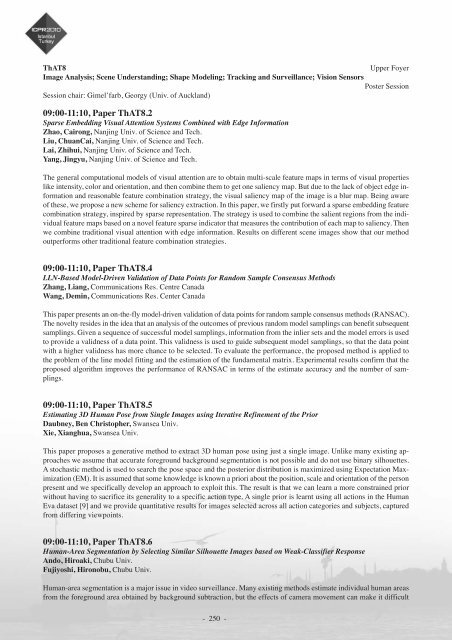Abstract book (pdf) - ICPR 2010
Abstract book (pdf) - ICPR 2010
Abstract book (pdf) - ICPR 2010
- TAGS
- abstract
- icpr
- icpr2010.org
You also want an ePaper? Increase the reach of your titles
YUMPU automatically turns print PDFs into web optimized ePapers that Google loves.
ThAT8 Upper Foyer<br />
Image Analysis; Scene Understanding; Shape Modeling; Tracking and Surveillance; Vision Sensors<br />
Poster Session<br />
Session chair: Gimel’farb, Georgy (Univ. of Auckland)<br />
09:00-11:10, Paper ThAT8.2<br />
Sparse Embedding Visual Attention Systems Combined with Edge Information<br />
Zhao, Cairong, Nanjing Univ. of Science and Tech.<br />
Liu, ChuanCai, Nanjing Univ. of Science and Tech.<br />
Lai, Zhihui, Nanjing Univ. of Science and Tech.<br />
Yang, Jingyu, Nanjing Univ. of Science and Tech.<br />
The general computational models of visual attention are to obtain multi-scale feature maps in terms of visual properties<br />
like intensity, color and orientation, and then combine them to get one saliency map. But due to the lack of object edge information<br />
and reasonable feature combination strategy, the visual saliency map of the image is a blur map. Being aware<br />
of these, we propose a new scheme for saliency extraction. In this paper, we firstly put forward a sparse embedding feature<br />
combination strategy, inspired by sparse representation. The strategy is used to combine the salient regions from the individual<br />
feature maps based on a novel feature sparse indicator that measures the contribution of each map to saliency. Then<br />
we combine traditional visual attention with edge information. Results on different scene images show that our method<br />
outperforms other traditional feature combination strategies.<br />
09:00-11:10, Paper ThAT8.4<br />
LLN-Based Model-Driven Validation of Data Points for Random Sample Consensus Methods<br />
Zhang, Liang, Communications Res. Centre Canada<br />
Wang, Demin, Communications Res. Center Canada<br />
This paper presents an on-the-fly model-driven validation of data points for random sample consensus methods (RANSAC).<br />
The novelty resides in the idea that an analysis of the outcomes of previous random model samplings can benefit subsequent<br />
samplings. Given a sequence of successful model samplings, information from the inlier sets and the model errors is used<br />
to provide a validness of a data point. This validness is used to guide subsequent model samplings, so that the data point<br />
with a higher validness has more chance to be selected. To evaluate the performance, the proposed method is applied to<br />
the problem of the line model fitting and the estimation of the fundamental matrix. Experimental results confirm that the<br />
proposed algorithm improves the performance of RANSAC in terms of the estimate accuracy and the number of samplings.<br />
09:00-11:10, Paper ThAT8.5<br />
Estimating 3D Human Pose from Single Images using Iterative Refinement of the Prior<br />
Daubney, Ben Christopher, Swansea Univ.<br />
Xie, Xianghua, Swansea Univ.<br />
This paper proposes a generative method to extract 3D human pose using just a single image. Unlike many existing approaches<br />
we assume that accurate foreground background segmentation is not possible and do not use binary silhouettes.<br />
A stochastic method is used to search the pose space and the posterior distribution is maximized using Expectation Maximization<br />
(EM). It is assumed that some knowledge is known a priori about the position, scale and orientation of the person<br />
present and we specifically develop an approach to exploit this. The result is that we can learn a more constrained prior<br />
without having to sacrifice its generality to a specific action type. A single prior is learnt using all actions in the Human<br />
Eva dataset [9] and we provide quantitative results for images selected across all action categories and subjects, captured<br />
from differing viewpoints.<br />
09:00-11:10, Paper ThAT8.6<br />
Human-Area Segmentation by Selecting Similar Silhouette Images based on Weak-Classifier Response<br />
Ando, Hiroaki, Chubu Univ.<br />
Fujiyoshi, Hironobu, Chubu Univ.<br />
Human-area segmentation is a major issue in video surveillance. Many existing methods estimate individual human areas<br />
from the foreground area obtained by background subtraction, but the effects of camera movement can make it difficult<br />
- 250 -



